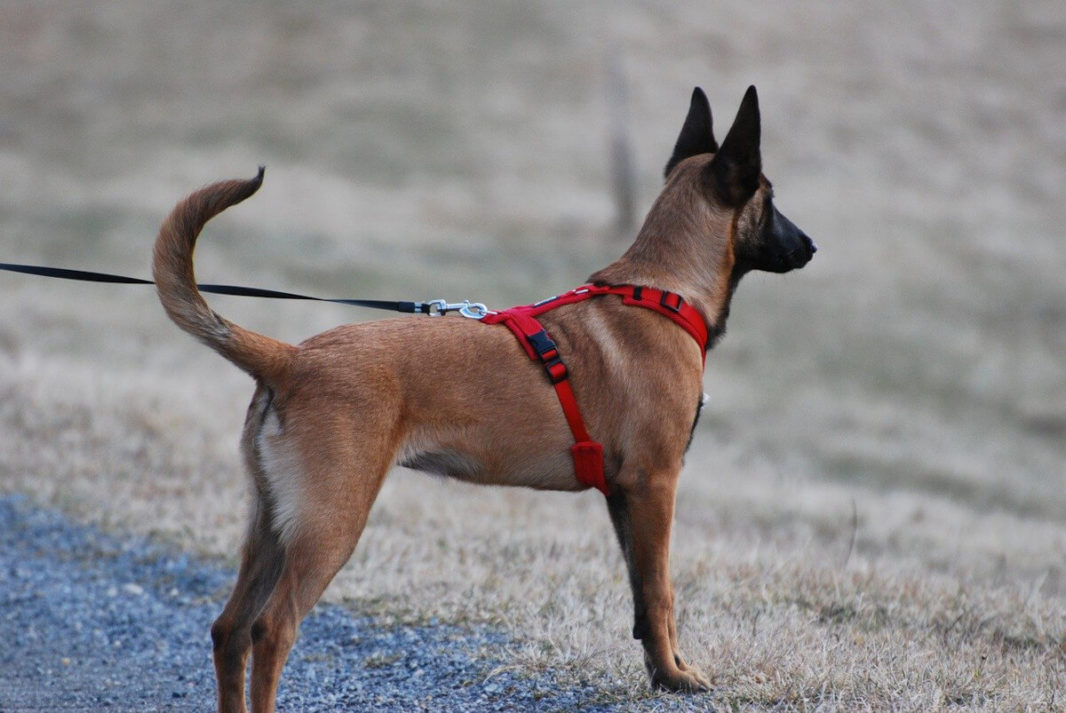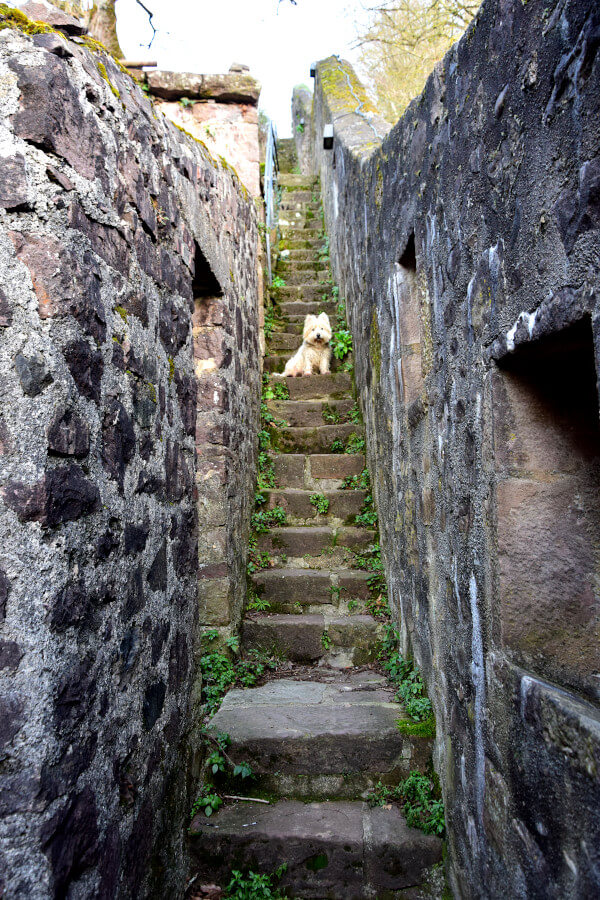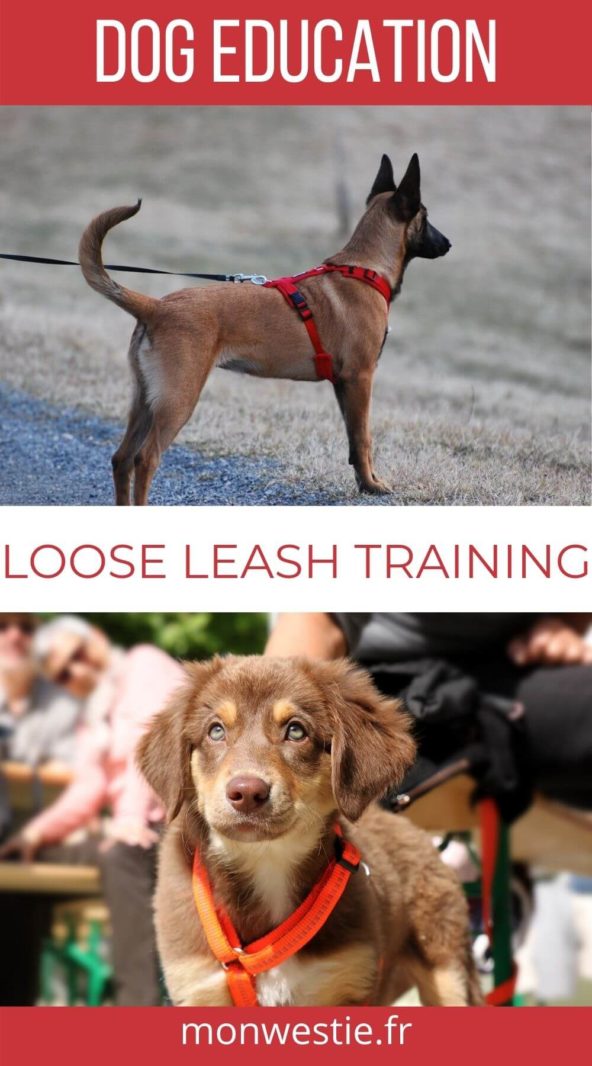Loose leash training a puppy or an adult dog can seem tricky, especially when you see some owners being walked by their dog… Dog and puppy pulling on leash is the most frequent problem of dog owners.
However, with the right accessories, rigor, method and patience, you will see that loose leash walking training is not so complicated.
In this article, I will tell you how Mom taught me to walk on a leash and to walk to heel at the same time.
In this article you will learn:
- which accessories you need for teaching a dog to heel.
- what is loose leash walking.
- 9 easy steps for training puppy or adult dog to walk on leash.
If you are looking for tips and tricks about early puppy early training, check out this article

The Choice of the Dog Leash and Harness are Fundamental.
Best Puppy Leashes.
To teach your puppy or dog to walk on a leash, you will need a classic leash – so no canicross belt, too elastic, or retractable leash.
You need a leash that is stiff, not too long and that you can easily shorten. I will explain why below. You don’t need a puppy leash. It can be used later when your dog will grow.
Below is a suitable model. You don’t need an expensive leash, except if you want a beautiful one. This one is really great as you can hold your dog very close to you when teaching walking to heel.
Click here to read client reviews and order
If you have a big dog pulling a lot, this is the best leash for dogs that pull here
You can use it both as a normal leash and a no-pull leash
This article contains compensated links. As an Amazon Associate I earn from qualifying purchases. Consult the disclaimer on the site for more information.
No Pull Leash.
If you have a big dog pulling a lot, this is the best leash for dogs that pull here
You can use it both as a normal leash and a no-pull leash.
You Need a Two Dog Leash?
Check below.
Both need a two dog and hand free leash?
Check below!
Choosing the Right Harness for Dog Leash Training.
For training dog to walk on leash without the risk of injuring him by pressing on his trachea, I recommend the use of a harness.
You will find below the Julius K9 harness, perfect for this training. I recommend that you read my article on harnesses to learn how to choose and use it properly. A properly fitting harness is a safe harness.
No-Pull Harness.
For the most difficult cases, especially if you have a big, strong dog and he pulls a lot, there are no pull harnesses available.
To learn more about this type of harness, read my article above.
Choke Training Collar ou E-Collar.
Even though this type of training collar or choke collar was recommended to Mom by a training club for walking dog training, she is far from being a fan of this option. In fact, she has only been to their training sessions once, their methods being far too harsh and based on punishment… Even though e-collar brands argue to teach dogs in a humane way, sending a vibration in the neck is not humane for her.
Read this article on the dangers of these collars
She had been there when I was very dominant. With firmness and patience, I finally gave her my full confidence and I calmed down.
It must also be said that Mom didn’t understand that my grunts were not aggressive…
In conclusion, you will find a selection of choke collars and e-collars below; however, if you follow the advice in this article, a single harness and leash should suffice.
What is Loose Leash Walking?
Loose leash walking means your dog is able to walk to heel with no stress on the leash and never pull on the leash.
1. Start getting your dog used to wearing the harness or collar.
By gradually getting your dog used to wearing his harness or collar while staying at home, it will be easier to walk him with it.
2. Teach your dog to always walk on your left side.
From the very beginning of teaching, it is important to position yourself well in relation to your dog.
Always hold him on the same side, to your left. Hold the leash with your left hand as well.
Why put your dog on the left? Quite simply because you use your right hand much more, especially – at least before the Covid-19 – to greet.
Note: With Mom, we did pet sitting twice for the same Scottish Terrier in Saint Paul de Vence. She was walking very badly on a leash. Mom tied us together. Not only did Coco walk next to me, but also, very naturally, I took the leader’s place on the right. As soon as Coco got on the wrong side, I would turn to the right!!!
3. Your dog should always walk next to you.
Training dogs to heel can be done while teaching your dog to walk on a leash. It is because your dog has to stay close to you the whole time when on a leash.
He should be neither forward nor backward and he should stand close to you.
If he moves to the side, forward or backward, shorten the leash to bring it back close to your left leg. That’s why I recommended a classic leash, which is easier and quicker to handle/adapt.
4. Talk to your dog and praise him.
It is important that your dog understands what you want from him.
Always use the same term, e.g. “to heel” for the walking position next to your left leg. When alternating with off-leash walking, use the same term. Your dog will associate the word with this position.
Congratulate him/her very often, especially at the beginning. He’ll be both proud and happy to please you, and he’ll understand that he’s doing the right thing.
To reward him, you can give him small reward cookies. But don’t do it all the time.
Note: Very often, when we walk along a road, Mom doesn’t even need to tell me “to the foot” when a car comes. I do it spontaneously. However, she has kept the habit of doing it, so I don’t think I can stop going to heel when a car comes. And when I’m tired, I don’t want to do it and Mom has to insist…
5. Alternate Walking on a Leash and Walking to Heel.
This technique worked very well with me.
Once I understood that I had to stay at Mom’s heel and close to her left leg, she sometimes walked me without a leash when we were still living in the city.
In fact, I walked around as often, if not more, than on a leash. So I learned both very quickly and, even though I prefer to be free, I accept being tied up very well.

6. Force your Dog to Walk at your Own Pace.
Vary your walking speed regularly, stop, so that your dog adapts to you and not the other way around. He must understand that you are the boss!
7. How to Stop Dog from Pulling on Leash?
If your dog is pulling and only do what he wants to do, bring him close to your left leg and stop completely until he calms down.
Do it again whenever he is tempted to go faster than you or to pull. He will soon understand that there is no need to insist.
8. Orders you can Use.
Keep your orders simple and direct.
For example, you can use the same ones we use. Do not hesitate to precede the order with the first name of the dog.
- “To Heel”: for walking on a leash and to heel.
- “To Heel, good”: to congratulate for walking well to heel.
- “Pavement / side”: when your dog is as obedient as I am and can walk without being always close to you, use this command to tell your dog to walk on the sidewalk or roadside.
- “Car, pavement / side”: so that he understands that there is a car and that he must stay on the side.
- “Side is fine”.
- “Here”.
- “No”.
- “No touching”.
- “Stop” or “stop car” to stop at the crosswalk. Then “sit”.
- “Hurry, fast” by accelerating the pace to cross quickly.
Use these words in both contexts – leash and off-leash – especially to learn about waiting at crosswalks. Even without a leash, I am able to cross safely, even when there are two crosswalks in a row, traffic and the need to stop. I even sit down without Mom having to say “sit” after her “stop”.
9. Beware of your Intonation.
Your intonation must be “authoritative” but there’s no point in shouting.
Your dog must understand from your tone that this is an order. He is quite capable of telling the difference between a “compelling order” and a simple request.
For example, sometimes I don’t feel like kissing or coming home from the garden. Because I know that Mom respects my wishes, I always obey orders, but not necessarily just wishes or requests.
FAQ on Loose Leash Training.
No. Learning will take more time, but it is entirely possible.
No. Positive education is very effective for training puppy to walk on leash or to heel (reward cookies, congratulations, petting).
No. Once your dog has fully mastered recall, on leash and off-leash walking, you can give him more freedom, as long as he doesn’t stray too far.
Not in France. The law prohibits rambling, which is totally different. If your dog remains within sight and voice of you, he is not considered to be raving. Therefore, you cannot be fined. On the other hand, some municipalities have specific by-laws where it may be mandatory to keep your dog on a leash.
Conclusion – Training a Dog to Walk to Heel.
Loose leash training can be very quick if you use the right accessories and the right attitude.
Thanks to this early learning of walking, with or without a leash, I can walk quietly. Mom knows that I will never go far away and that I am always waiting for her.
Even if your dog is an adult, dog pulling on leash should be a souvenir very soon. Training your dog to walk on a leash, even at the adult age, is absolutely possible.
As with a child, you must be consistent: always the same orders, always the same result in case of disobedience. Your dog must understand that you are the master / leader of the herd and that he must obey you.
I hope these 9 tips for walking puppy on leash and to heel will help you! Tell us if you have tried it and how it worked in the comment section below.
For more education tips, see this section.
This article contains compensated links. As an Amazon Associate I earn from qualifying purchases. Consult the disclaimer on the site for more information.
Save on Pinterest for later.









Great info. I was using a collar and retractable leash. I feel like I started out wrong. I did buy a harness for my 9 week old Westie but she gets it stuck in her mouth. I guess I’ll get one you recommend . Thank you for this great blog